TT eSPORTS Meka G-Unit White - White Knight with Mechanical Heart
To the delight of many, peripheral manufacturers once again turned their attention to keyboards with a mechanical way to register the click of a button. In 99% of cases, “clickers” are made by Cherry, and they are placed not only in pathos ergonomic models, but also in completely combat “gaming” devices. In the end, gamers are also people and also want high-quality input of information. Especially in difficult conditions.
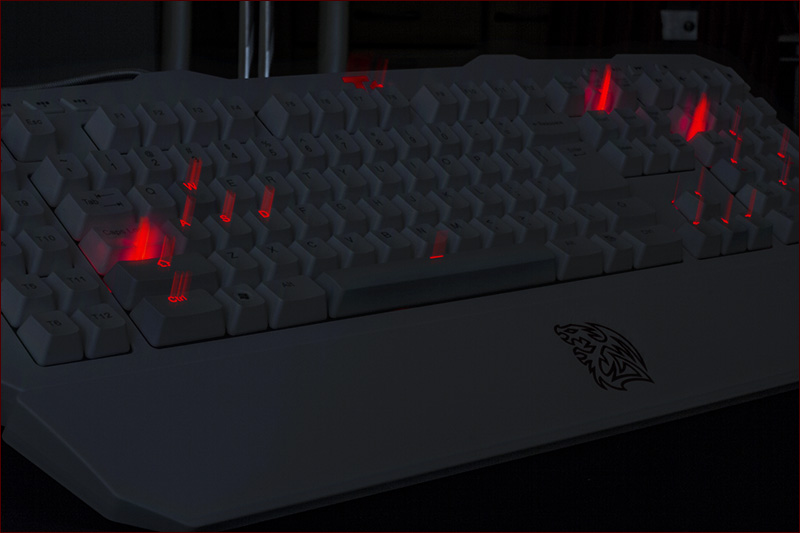
There are not many mechanical keyboards on the market - Cherry by itself (try to find it, huh), DasKeyboard (to order), a couple of models from Razer, SteelSeries had some kind, CoolerMaster and Tt eSPORTS, actually. BlackWidow overlooked on Habr. Comrade Flagman, well, my new acquaintances got me a rare thing - white mechanics from the Thermaltake eSports division. (In fact, the “nishtyakovs” were immediately brought in a bunch, but you won’t put everything in one text, and you’ll get tired of reading, so we’ll cut it off for hours;).
The keyboard comes in an inconspicuous black box of completely normal quality, so there’s simply nothing to photograph there. And since I already had “Black Widow”, it’s just not going to push two titans between their foreheads, especially since the confrontation is also in color.
Theormech
The first, and perhaps the most important difference between the two keyboards is “clickers”. Those notorious gizmos that are responsible, in fact, for the very press of a button. The “widow” (and many other keyboards) uses one of the most popular models, the so-called “blue” series.
Its “mechanics” look like this:
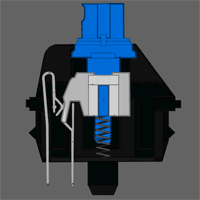
It is the “falling” white shit that makes the keyboard click nobly. The noise from fast printing is colossal. For games, such switches are suitable, but not ideal. The fact is that the point at which the “reverse stroke” begins to work (the point to which the next drowning of the key down will not be considered a new press, but will be considered as holding the previous one), is slightly higher than the point at which the press is recorded .
For clarity, I ask you to pay attention to the following diagram:

A quick double click is possible, but rather difficult.
Meka uses the “black” series of switches (identical to red, only the effort is different, so for clarity I will use a picture with a red clicker). The mechanics of work are as follows:
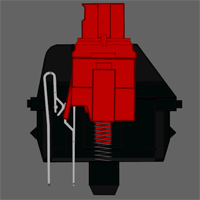
The cap that fell down at the “blue” ruler is tightly attached here. The force of such a key is almost uniform over the entire length of the stroke (the absence of a “hump” on the part that enters the metal “ear” is responsible for this), and the keystroke is recorded at the same moment as the key has a reverse stroke and the electronics understand that the button released at the very moment when the threshold value of pressing returned to the point at which the "click" was recorded.
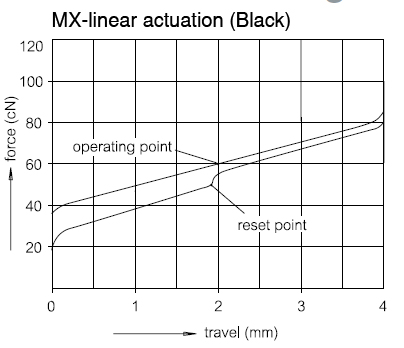
Thus, theoretically, the black “clicker” is slightly more adapted to games than the “blue”, and differs slightly in sensations “under the fingers”.
In practice, the differences are striking. Firstly, the keyboard behaves much quieter. Noble mechanical “grunts” didn’t go away when printing, but there are no high and distinct clicks. The effort on the keys gradually increases, and their “threshold sensitivity” allows you to type both at a relaxed pace, just touching the keys, and pressing furiously at one hundred and a few buttons, scribbling at the speed of a good machine gun.
Appearance and equipment
In the box, in addition to the white beauty, there is: a wrist rest, drivers (again a drive, useless, in my opinion, junk), a bag with something inside. It (in the bag) contains a detachable USB cable, which, depending on the location of things on the table and the type of monitor, can be connected and displayed on the right, or (by swiping under the keyboard) displayed on the left. The same BlackWidow cable is twice as thick, attached “tightly”, and contains at the end two USB-tails and two 3.5-mm connectors for audio accessories (in the case of the Ultimate version).
The case is made of a pleasant to the touch white matte plastic. To start, no matter how surprising it may sound, I want to from the bottom of the keyboard.
The body is riddled with stiffening ribs, all bolts are covered with special seals, and the bottom is dotted with areas with a rubber surface - the keyboard is as reliable as the mausoleum in the red square, and does not move until youbring the bulldozers do not want to.

Well, if you are used to using the keyboard “with a lift”, you can fold out two “legs”, on the sides of which rubber spacers are also applied. The angle of inclination will change significantly, and the stability on the table will not change one iota. The keyboard is reliably protected from sliding on any surface, and for the reasonableness of the solution gets an honest 10 points.
On the “rear panel”, where the USB cable is connected, there are two more USB outputs (not requiring a separate USB slot from your computer, unlike the “Widow”), microphone input and headphone output. Nothing ordinary, but we will return to this place. The cable, by the way, is easy to throw from the “left” side to the right, if you are not happy with something by default location.
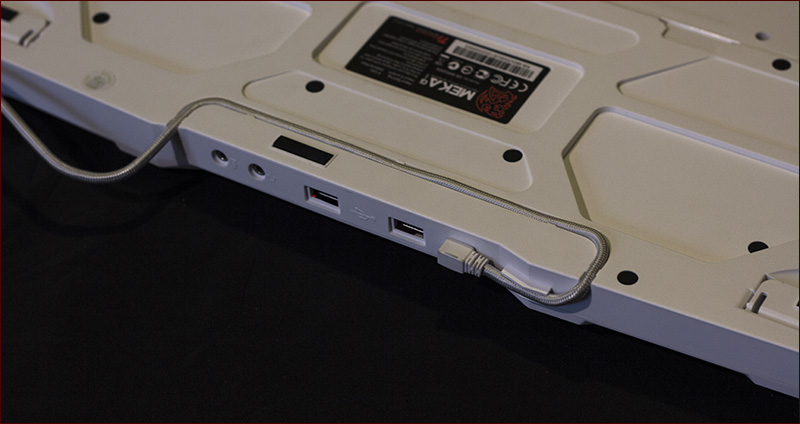
Layout and Buttons
Now - the most delicious layout. To be honest, the keyboard is very difficult to call small. In addition to the non-acidic side “margins” on each side, the size of the keys is also slightly wider than that of BlackWidow. In addition to this, the keyboard is awarded a scattering of additional keys. A macro block, unlike Razer products, contains not five but twelve macro buttons: two rows of six pieces. Above the Escape key there are three buttons for profiles and a “game mode” button, which includes additional macros that can be hung on any text key, and disables the Win button (clicking on it causes a “response” of the Ctrl key).
In the right part above the Num-block there are multimedia keys responsible for playing music and the volume of the device + backlight button.
All of the above benefits in the form of dedicated buttons on the "widow" are called by the combination FN + F1 ... F12, which, admittedly, is much less convenient.
The layout itself is “hybrid”, the enter is L-shaped (fu fu, I do not like it), backslas treacherously lurks before the right cipher. On the left - everything is human, in front of the cipher no one got extra buttons, the spacebar is of normal width and is not framed by any idiocy.

Regarding the layout of the print unit, unfortunately, I like the Widow more (by the way, we say hello to the guys from Razer for their crooked layout on Anansi). I got the “European” keyboard in the “tournament” version for the test, no Russian characters were printed on the keys. In principle, blind printing has never failed, so I had no problems with the set of this review.
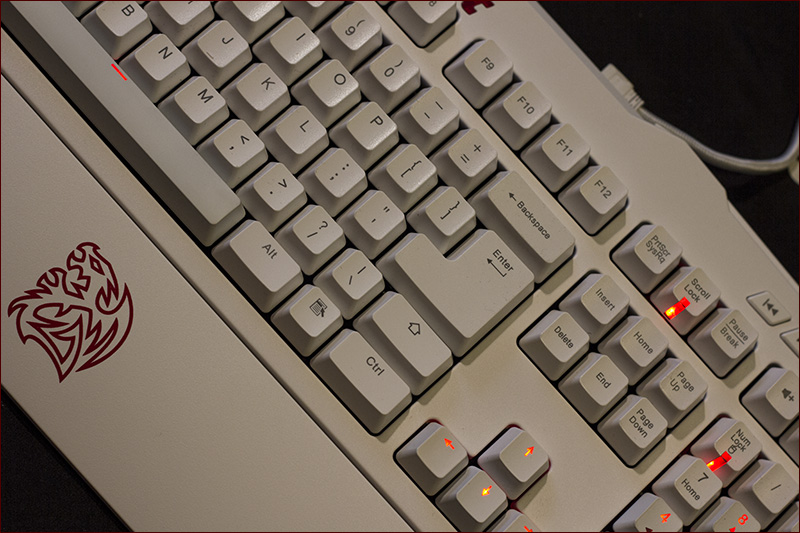
But the “Tournament” consists in a stripped down highlighting - only the arrow keys are highlighted, the WASD block, the Tt logo, Caps, Num and Scroll - locks (a great solution, which is much better than the dull and dull indicators of the Widow), yes, actually and that’s it. The backlight has three levels (33, 66 and 100% + pulsating mode). Naturally, no one forbids you to completely turn it off. They promised to show the full-backlight version a little later, it pleases that the company took care of the "mere mortals".
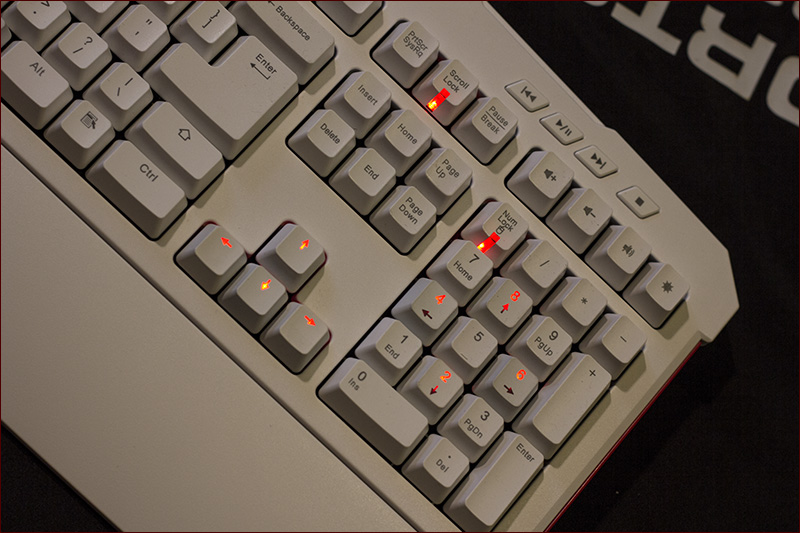
We turn directly to the sensations of work (since I spoke about mechanics at the very beginning, and the whole appearance has already been described).
Sound, camera, motor
Well, firstly, the keyboard is not silent, but several times quieter than the “blue” “Black Widow”. At least my woman no longer swears when I print something at night.
The key travel is sure, the trigger point is felt pretty well, but there is no pronounced non-linearity of the move. The force grows evenly a little throughout the entire four-millimeter stroke of the key, and all buttons are pressed confidently and easily.
The macro-block is a miracle, conveniently divided into three groups of four keys (squares), it is easy to feel blindly and perfectly “mindmaps”. I have there the main part of Photoshop tools in one of the profiles was uploaded.
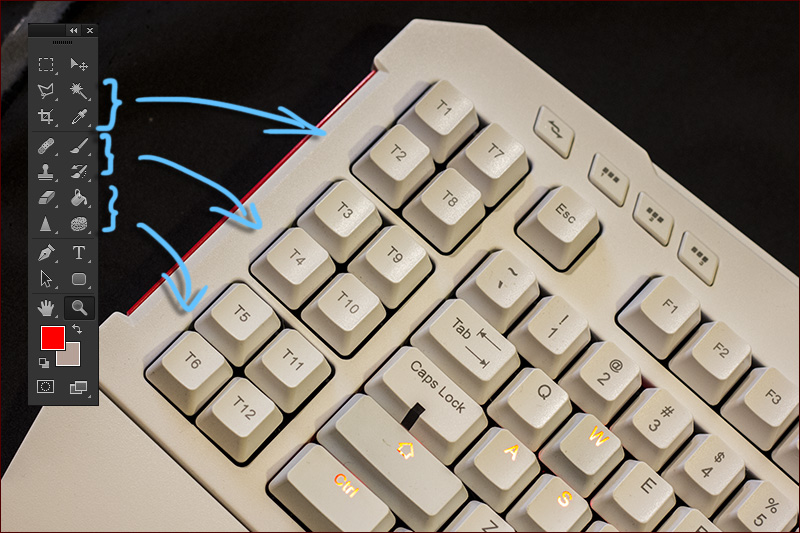
All the large keys also do not cause complaints - they are supported in the right places and do their job perfectly, do not bend, do not stagger, and in general I can not complain about the quality.
I did not like the order of the buttons above the digital unit. The current order is “Volume Up”, “Volume Down”, “Volume To Zero”, “Backlight”. In Europe and Russia they read from left to right, so instead of increasing the volume, I often got into the “mute”.
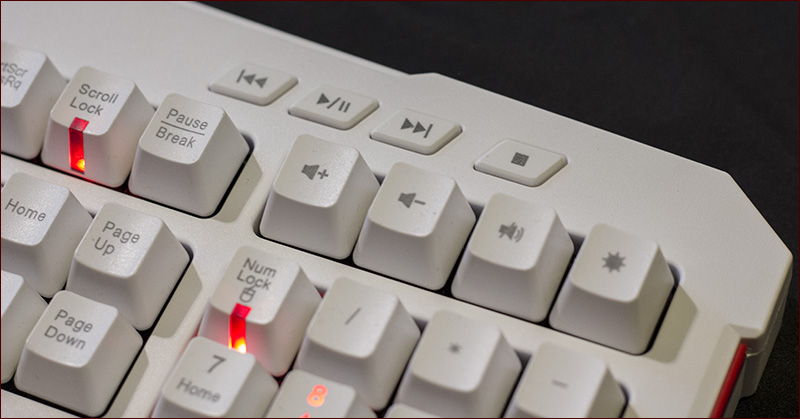
Pleasant bonus
And now a part for attentive readers. As you remember, the keyboard is connected via one USB cable, and contains additional USB ports and audio input / audio output. Since nothing happened when connecting speakers, a headset and a microphone to the keyboard, the very first thought was “for sure, I didn’t connect the audio cable”. But it’s not in the box! And there’s nowhere to connect. And then it dawns on me - what if ... with the right button on the “sound” in the tray, the playback device ... and now it turns out that a sound card is built into the keyboard.

A very, very good solution, a minimum of wires, a maximum of useful things, and even a USB hub has not gone anywhere. In addition, the sound for such a solution turned out to be quite pleasant, not a sound for 200 bucks, of course, but it was better built into the motherboard and even more so built into most laptops and nettops / all-in-ones. Additional advantages in karma for developers for such a solution.
To summarize?
So, let's start with the positive aspects:
Not without minuses:
The remaining "cons" are subjective, so they fall into the category of "controversial":
In general, I really, really liked the Tt eSPORTS Meka G-Unit. Comfortable, reliable, beautiful and unusual, it attracts glances (and also dust and prints, if someone didn’t wash their hands!), Perfectly lies “under the fingers” and performs its functions. The built-in sound card easily surpasses the tweeters built into the motherboard, and the USB hub allows you to stick a USB flash drive or card reader without breaking through to the back wall of the system unit and without climbing under the table.

“Meka” has plenty of advantages, disadvantages from the point of view of software are fixable, and controversial issues are controversial, so that they can be hotly discussed in the comments, because truth is born in the dispute. Fight!

There are not many mechanical keyboards on the market - Cherry by itself (try to find it, huh), DasKeyboard (to order), a couple of models from Razer, SteelSeries had some kind, CoolerMaster and Tt eSPORTS, actually. BlackWidow overlooked on Habr. Comrade Flagman, well, my new acquaintances got me a rare thing - white mechanics from the Thermaltake eSports division. (In fact, the “nishtyakovs” were immediately brought in a bunch, but you won’t put everything in one text, and you’ll get tired of reading, so we’ll cut it off for hours;).
The keyboard comes in an inconspicuous black box of completely normal quality, so there’s simply nothing to photograph there. And since I already had “Black Widow”, it’s just not going to push two titans between their foreheads, especially since the confrontation is also in color.
Theormech
The first, and perhaps the most important difference between the two keyboards is “clickers”. Those notorious gizmos that are responsible, in fact, for the very press of a button. The “widow” (and many other keyboards) uses one of the most popular models, the so-called “blue” series.
Its “mechanics” look like this:

It is the “falling” white shit that makes the keyboard click nobly. The noise from fast printing is colossal. For games, such switches are suitable, but not ideal. The fact is that the point at which the “reverse stroke” begins to work (the point to which the next drowning of the key down will not be considered a new press, but will be considered as holding the previous one), is slightly higher than the point at which the press is recorded .
For clarity, I ask you to pay attention to the following diagram:

A quick double click is possible, but rather difficult.
Meka uses the “black” series of switches (identical to red, only the effort is different, so for clarity I will use a picture with a red clicker). The mechanics of work are as follows:

The cap that fell down at the “blue” ruler is tightly attached here. The force of such a key is almost uniform over the entire length of the stroke (the absence of a “hump” on the part that enters the metal “ear” is responsible for this), and the keystroke is recorded at the same moment as the key has a reverse stroke and the electronics understand that the button released at the very moment when the threshold value of pressing returned to the point at which the "click" was recorded.

Thus, theoretically, the black “clicker” is slightly more adapted to games than the “blue”, and differs slightly in sensations “under the fingers”.
In practice, the differences are striking. Firstly, the keyboard behaves much quieter. Noble mechanical “grunts” didn’t go away when printing, but there are no high and distinct clicks. The effort on the keys gradually increases, and their “threshold sensitivity” allows you to type both at a relaxed pace, just touching the keys, and pressing furiously at one hundred and a few buttons, scribbling at the speed of a good machine gun.
Appearance and equipment
In the box, in addition to the white beauty, there is: a wrist rest, drivers (again a drive, useless, in my opinion, junk), a bag with something inside. It (in the bag) contains a detachable USB cable, which, depending on the location of things on the table and the type of monitor, can be connected and displayed on the right, or (by swiping under the keyboard) displayed on the left. The same BlackWidow cable is twice as thick, attached “tightly”, and contains at the end two USB-tails and two 3.5-mm connectors for audio accessories (in the case of the Ultimate version).
The case is made of a pleasant to the touch white matte plastic. To start, no matter how surprising it may sound, I want to from the bottom of the keyboard.
The body is riddled with stiffening ribs, all bolts are covered with special seals, and the bottom is dotted with areas with a rubber surface - the keyboard is as reliable as the mausoleum in the red square, and does not move until you

Well, if you are used to using the keyboard “with a lift”, you can fold out two “legs”, on the sides of which rubber spacers are also applied. The angle of inclination will change significantly, and the stability on the table will not change one iota. The keyboard is reliably protected from sliding on any surface, and for the reasonableness of the solution gets an honest 10 points.
On the “rear panel”, where the USB cable is connected, there are two more USB outputs (not requiring a separate USB slot from your computer, unlike the “Widow”), microphone input and headphone output. Nothing ordinary, but we will return to this place. The cable, by the way, is easy to throw from the “left” side to the right, if you are not happy with something by default location.

Layout and Buttons
Now - the most delicious layout. To be honest, the keyboard is very difficult to call small. In addition to the non-acidic side “margins” on each side, the size of the keys is also slightly wider than that of BlackWidow. In addition to this, the keyboard is awarded a scattering of additional keys. A macro block, unlike Razer products, contains not five but twelve macro buttons: two rows of six pieces. Above the Escape key there are three buttons for profiles and a “game mode” button, which includes additional macros that can be hung on any text key, and disables the Win button (clicking on it causes a “response” of the Ctrl key).
In the right part above the Num-block there are multimedia keys responsible for playing music and the volume of the device + backlight button.
All of the above benefits in the form of dedicated buttons on the "widow" are called by the combination FN + F1 ... F12, which, admittedly, is much less convenient.
The layout itself is “hybrid”, the enter is L-shaped (fu fu, I do not like it), backslas treacherously lurks before the right cipher. On the left - everything is human, in front of the cipher no one got extra buttons, the spacebar is of normal width and is not framed by any idiocy.

Regarding the layout of the print unit, unfortunately, I like the Widow more (by the way, we say hello to the guys from Razer for their crooked layout on Anansi). I got the “European” keyboard in the “tournament” version for the test, no Russian characters were printed on the keys. In principle, blind printing has never failed, so I had no problems with the set of this review.

But the “Tournament” consists in a stripped down highlighting - only the arrow keys are highlighted, the WASD block, the Tt logo, Caps, Num and Scroll - locks (a great solution, which is much better than the dull and dull indicators of the Widow), yes, actually and that’s it. The backlight has three levels (33, 66 and 100% + pulsating mode). Naturally, no one forbids you to completely turn it off. They promised to show the full-backlight version a little later, it pleases that the company took care of the "mere mortals".

We turn directly to the sensations of work (since I spoke about mechanics at the very beginning, and the whole appearance has already been described).
Sound, camera, motor
Well, firstly, the keyboard is not silent, but several times quieter than the “blue” “Black Widow”. At least my woman no longer swears when I print something at night.
The key travel is sure, the trigger point is felt pretty well, but there is no pronounced non-linearity of the move. The force grows evenly a little throughout the entire four-millimeter stroke of the key, and all buttons are pressed confidently and easily.
The macro-block is a miracle, conveniently divided into three groups of four keys (squares), it is easy to feel blindly and perfectly “mindmaps”. I have there the main part of Photoshop tools in one of the profiles was uploaded.

All the large keys also do not cause complaints - they are supported in the right places and do their job perfectly, do not bend, do not stagger, and in general I can not complain about the quality.
I did not like the order of the buttons above the digital unit. The current order is “Volume Up”, “Volume Down”, “Volume To Zero”, “Backlight”. In Europe and Russia they read from left to right, so instead of increasing the volume, I often got into the “mute”.

Pleasant bonus
And now a part for attentive readers. As you remember, the keyboard is connected via one USB cable, and contains additional USB ports and audio input / audio output. Since nothing happened when connecting speakers, a headset and a microphone to the keyboard, the very first thought was “for sure, I didn’t connect the audio cable”. But it’s not in the box! And there’s nowhere to connect. And then it dawns on me - what if ... with the right button on the “sound” in the tray, the playback device ... and now it turns out that a sound card is built into the keyboard.

A very, very good solution, a minimum of wires, a maximum of useful things, and even a USB hub has not gone anywhere. In addition, the sound for such a solution turned out to be quite pleasant, not a sound for 200 bucks, of course, but it was better built into the motherboard and even more so built into most laptops and nettops / all-in-ones. Additional advantages in karma for developers for such a solution.
To summarize?
So, let's start with the positive aspects:
- Build quality;
- Materials
- Bottom construction;
- Execution of “clickers” and buttons;
- One cable;
- Built-in sound card with good performance;
- Convenient and reliable wrist rest;
- Cable management.
Not without minuses:
- Limited number of profiles;
- Limited software;
- The order of the keys responsible for the volume;
- Heavyweight drivers.
The remaining "cons" are subjective, so they fall into the category of "controversial":
- Keyboard layout: shift, backslash and enter (subjectivity);
- Backlight (we are waiting for the version with a fully illuminated "canvas");
- White - gets dirty (wash my hands, yeah);
- Price (it’s not a pity to pay for a good thing, it’s a blessing that they ask not so much - about 150 evergreens).
In general, I really, really liked the Tt eSPORTS Meka G-Unit. Comfortable, reliable, beautiful and unusual, it attracts glances (and also dust and prints, if someone didn’t wash their hands!), Perfectly lies “under the fingers” and performs its functions. The built-in sound card easily surpasses the tweeters built into the motherboard, and the USB hub allows you to stick a USB flash drive or card reader without breaking through to the back wall of the system unit and without climbing under the table.

“Meka” has plenty of advantages, disadvantages from the point of view of software are fixable, and controversial issues are controversial, so that they can be hotly discussed in the comments, because truth is born in the dispute. Fight!
